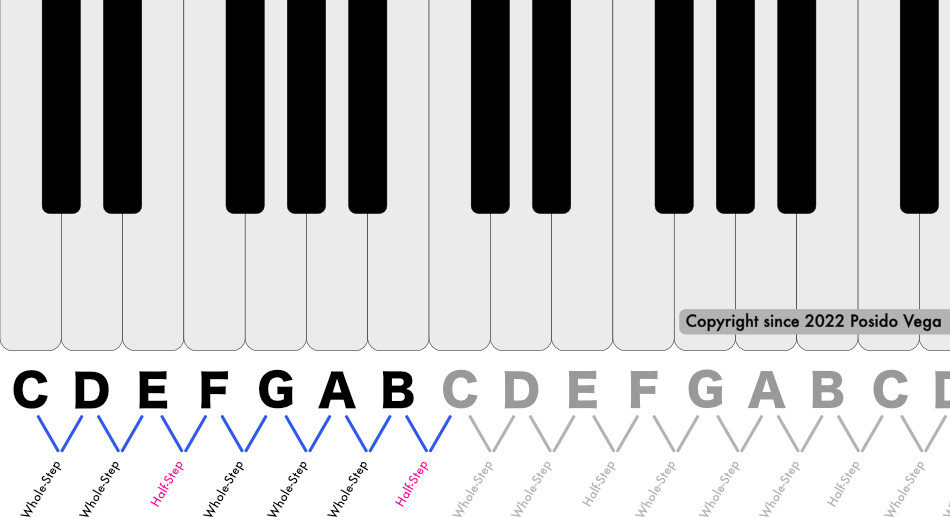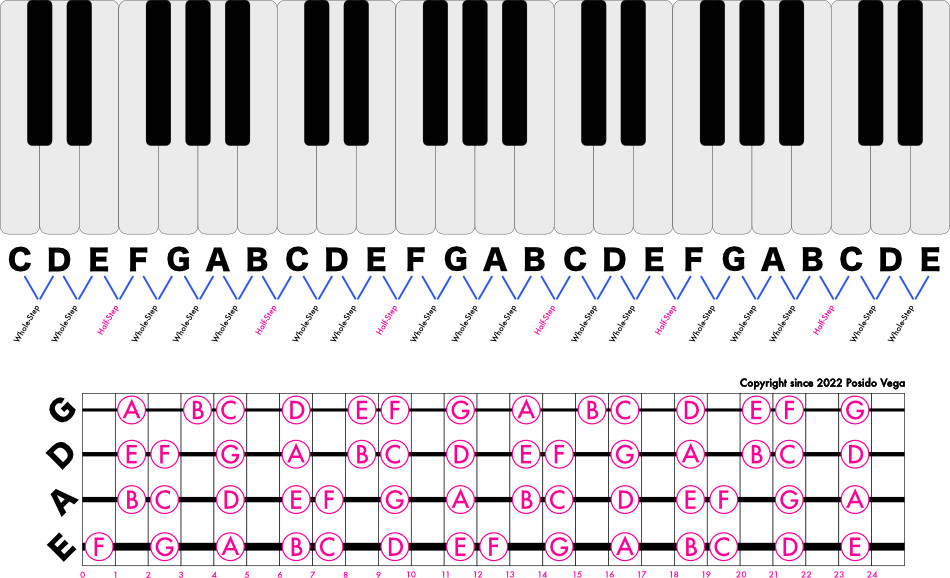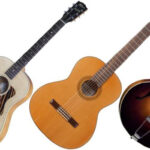I’ve spent over a decade teaching bass guitar, and it consistently surprises me how many players, even those with years of experience, haven’t fully grasped the notes across their bass guitar neck.
But it doesn’t have to be that way.
Learning the notes on your bass guitar neck shouldn’t be a long, drawn-out process. The fretboard is built on a logical system. Once you understand this underlying logic, everything clicks into place.
In this guide, I’m going to share: The precise four-step method I’ve used to help countless students, and that I personally used to internalize all the notes on the bass neck in just two weeks (complete with a video walkthrough).
Let’s dive in and get you navigating your bass neck with confidence.
Your Step-by-Step System to Learn Notes on the Bass Guitar Neck
The approach I developed to learn every single note on the fretboard boils down to these 4 straightforward steps:
I’ll break down each step in detail, provide helpful diagrams, and include a video explanation to guide you through the entire process.
Consider bookmarking this page as a handy reference, especially if you’re new to bass or find fretboard memorization challenging.
Quick Start: Video Overview
For those pressed for time, here’s a video outlining the exact method.
 YouTube video
YouTube video
Alt text: YouTube video thumbnail for “Learn Your Fretboard Bass Guitar Notes Fast! (4 Easy Steps)”. Play button visible on image.
Learn Your Fretboard Bass Guitar Notes Fast! (4 Easy Steps)
Step 1: Understanding the Interval Logic of Musical Notes
In most Western musical styles, you only need to learn 12 distinct notes. The most efficient way to learn these notes is by grasping the logical system of how they are named – one step at a time.
Key Insight: Musical notes follow alphabetical order. If you know your alphabet, specifically the letters A through G, you’re already more than halfway there.
A, B, C, D, E, F, and G are the foundation, accounting for seven notes. These are known as natural notes. Think of them as the white keys on a piano.
This sequence repeats endlessly across all instruments: A, B, C, D, E, F, G, A, B, C, D, E, F, G, and so on.
The remaining five notes are the sharps and flats: A♯/B♭, C♯/D♭, D♯/E♭, F♯/G♭, and G♯/A♭. These correspond to the black keys on a piano and are positioned between the natural notes.
You’ll notice that sharps and flats have two names – this is called enharmonic spelling. While the pitch is the same, the name can change depending on the musical context. For now, when you’re just starting to master your bass neck notes, don’t get bogged down in context. Understanding when to use sharps or flats will become more intuitive as your fretboard knowledge grows.
Whole Steps and Half Steps Explained
Look at a piano keyboard, and you’ll see black keys between most white keys, but not everywhere.
Crucial Tip: There’s no black key between E and F, and no black key between B and C. This rule holds true on any fretboard, whether bass or guitar!
 Piano keys – Whole-Step and Half-Step Diagram
Piano keys – Whole-Step and Half-Step Diagram
Alt text: Diagram of piano keys illustrating whole steps and half steps. E to F and B to C are marked as half steps, while other adjacent white keys separated by a black key are marked as whole steps.
The distance between E and F is always a half step (one fret). Similarly, the distance between B and C is always a half step (one fret).
All other natural notes are a whole step apart (two frets).
Now, let’s immediately apply this knowledge to your bass guitar neck. The method I’m about to show you is far less tedious than trying to memorize notes chromatically.
Step 2: Decoding the Logic of the Bass Guitar Fretboard
Let’s recap what we’ve learned:
- Musical notes are named alphabetically.
- E-F and B-C are always a half step apart.
- All other natural notes are a whole step (2 frets) apart.
Here’s the most essential fretboard logic to remember:
- Each fret on your bass neck represents a half step.
- Two frets equal a whole step.
On a standard four-string bass guitar, your open string notes.) are E, A, D, and G.
 Bass Guitar Fretboard Notes and Piano Notes Diagram
Bass Guitar Fretboard Notes and Piano Notes Diagram
Alt text: Diagram showing a bass guitar fretboard with note names on the E, A, D, and G strings, aligned with corresponding notes on a piano keyboard diagram above.
Let’s start with your lowest string, the E string. The easiest way to begin learning your bass guitar neck notes is string by string.
Remember, E-F and B-C are the only natural note pairs with no notes in between.
Finding the Notes on Your E-String (The Simple Approach)
Starting on your E-string, the first fret is F.
Using the alphabetical order of musical notes and the whole/half step rule, you can easily find all the natural notes on your E string:
- Two frets up from F is G.
- Two frets up from G is A.
- Two frets up from A is B.
- One fret up from B is C.
- Two frets up from C is D.
- Two frets up from D is E.
- And then the pattern repeats.
Let’s apply this same logic to the next string, the A-string.
Finding the Notes on Your A-String (The Simple Approach)
Here are the natural note locations on the A-string:
- Two frets up from A is B.
- One fret up from B is C.
- Two frets up from C is D.
- Two frets up from D is E.
- One fret up from E is F.
- Two frets up from F is G.
- Two frets up from G is A.
- Again, this pattern continues to repeat.
Let’s keep moving and find the natural notes on the D-string.
Finding the Notes on Your D-String (The Simple Approach)
The natural note locations on the D-string are:
- Two frets up from D is E.
- One fret up from E is F.
- Two frets up from F is G.
- Two frets up from G is A.
- Two frets up from A is B.
- One fret up from B is C.
- Two frets up from C is D.
- This repeating pattern will be familiar by now.
Just one more string to go! Let’s learn the bass guitar notes on the G-string.
Finding the Notes on Your G-String (The Simple Approach)
The natural note locations on the G-string are:
- Two frets up from G is A.
- Two frets up from A is B.
- One fret up from B is C.
- Two frets up from C is D.
- Two frets up from D is E.
- One fret up from E is F.
- Two frets up from F is G.
- And yes, this pattern repeats itself here as well!
Now, let’s take it up a notch and start working with octaves!
Step 3: Mastering Octave Shapes on the Bass Neck
This step is critical for dramatically speeding up your fretboard knowledge. Octaves act as landmarks across the neck. While any interval, like a 5th, can serve this purpose, I recommend starting with octaves for all beginner bass players because they represent the exact same note, just higher or lower, making them less confusing initially.
A perfect octave is the same note at double (or half) the frequency.
There are multiple octaves available on your bass guitar neck. Your goal is to learn where they all are.
Find and practice these octave shapes all along the neck of your bass.
Bass Guitar Fretboard Octaves Diagram
Alt text: Bass guitar fretboard diagram highlighting octave shapes with dots and lines connecting notes that are an octave apart.
Here are some easy-to-remember octave shapes:
- Move up two frets and up two strings to find an octave higher.
- Move down two frets and down two strings to find an octave lower.
- Move down three frets and up three strings to find an octave higher.
- Move up three frets and down three strings to find an octave lower.
- Move down five frets and up one string to find an octave higher.
- Move up five frets and down one string to find an octave lower.
- Move up seven frets and up one string to find an octave higher.
- Move down seven frets and down one string to find an octave lower.
Step 4: Practical Application in Musical Contexts (Learn Fast!)
While steps 1-3 build your knowledge of notes on the bass neck, it’s step 4 – applying this logic and using octaves as your guide – that will truly accelerate your learning.
Important: There’s no shortcut here. You need to play your bass and actively practice applying what you’ve learned.
The more you practice, the more these notes will become ingrained in your muscle memory, and you’ll master the fretboard much faster than you might expect.
In the video, I demonstrate how to apply these concepts using a simple bass line and a metronome for timing. While playing the root note, I consciously think about the location of the octave and then play the same bassline an octave higher.
You’ll quickly see how easy it becomes to find the notes across your fretboard in real musical situations.
(Bonus) Step 5: Verbalize Note Names During Practice
During each practice session, I recommend dedicating a few minutes to consciously saying the name of each note aloud as you play it.
Practice slowly and deliberately.
Focus on accuracy over speed.
This is an incredibly effective way to learn all the notes on the bass neck in a short amount of time. A technique I personally used frequently was to say the note name, locate the fret, and then play the note. When I was learning to read standard music notation, I would often vocalize the note names to reinforce their positions on the fretboard.
I would even do this during band rehearsals, jam sessions, and live performances. This way, I was actively learning while playing in real-time.
This forced me to think on my feet and boosted my confidence when I was starting out on bass.
Your Turn to Play
All this theoretical knowledge about fretboard logic and octaves is valuable, but it becomes truly powerful when you start putting it into practice.
Learning the notes on your bass guitar neck is essential for improvisation, reading music, and playing along to chord charts while maintaining solid timing.
So, start applying these techniques today, and you’ll see significant progress in just a few weeks.
For more resources and in-depth bass lessons, explore what’s inside My Sandbox.
Frequently Asked Questions
What are the Notes on a Bass Guitar? (Standard Tuning)
On a standard 4-string bass guitar, the open string notes are: E, A, D, and G.
For a 5-string bass, the open string notes are: B, E, A, D, and G.
For a 6-string bass, the open string notes are: B, E, A, D, G, and C.
The bass guitar in standard tuning is tuned in fourths. Understanding fourth intervals, similar to octaves, can also be a helpful pattern for navigating notes across strings.
What’s the Most Effective Way to Memorize Bass Guitar Notes?
A common question I hear is, “How do you memorize the notes on the bass?”
My answer is always, “You don’t, not primarily.”
It’s far more effective to understand the underlying logic of note names and the fretboard layout. Once you grasp this logic, the note locations on the neck become intuitive and make sense.
Develop good practice habits, such as noticing patterns and shapes and naming notes aloud. Trust the process.
Note memorization will occur naturally as you find connections and meaning in the information. Recognizing patterns and shapes is a key way to establish these mental connections.
How Do I Find Notes on the Bass Guitar Neck?
To find Notes On The Bass Guitar Neck, you need to understand the fretboard’s structure. A 4-string bass in standard tuning has strings tuned to E, A, D, and G. The fretboard layout mirrors a piano keyboard. Natural notes are a whole step apart, except for E and F (a half step) and B and C (a half step). All other natural notes are separated by a whole step.

